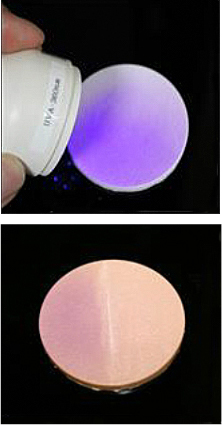About request order
BIODY Request order
①Material and resiliency②Basic 9 colors③Surface modification④UV responding chemical
Selection of raw material hardness, color, surface modification and UV responding chemical
We can respond to your various requests for BIODY products.
If you select the number of the model, the following four types of requests can be prepared.
①Selection of raw material and resiliency
②Selection of basic 9 colors
③Selection of Surface modification (dry skin feeling, normal type or moisture skin feeling)
④Selection of UV responding chemical
Please contact our staff for more details.)
①Selection of raw material and hardness
For BIODY, two kinds of raw materials are available.
According to your use, it is possible to specify either of them.
It is a thermoplastic urethane elastomer that we have been using since the release. It has high processability and excellent coloring properties.
It is ideal for applications that require specialized coloring and maintenance of shape.
In addition, you can choose 6 levels of hardness for bio-skin material.
Please choose one of the hardness(LV) in the hardness table below.
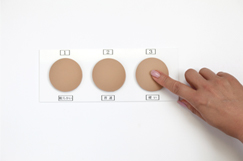
Urethane gel (11X gel) 0.21S
| Hardness(LV) | Hardness range(5T) |
Hardness range(10T) |
Notes |
|---|---|---|---|
| 1LV | E28〜30 | E28〜30 | Hardness in the orange column is the standard hardness of a ready-made item. If hardness is not specified, it becomes 2LV |
| 2LV | E22〜27 | E22〜27 | |
| 3LV | E19〜21 | E19〜21 | |
| 4LV | E15〜18 | E14〜18 | |
| 5LV | E12〜14 | E10〜13 | |
| 6LV | E9〜11 | E7〜9 |
Measuring equipments and conditions
1.Durometer(Teclock GS-721N:E type)
2.Constant pressure loader(Teclock GS-710)
3.Measurement method(JIS 6253 E)
4.Measuring time(15 seconds)
It is a urethane gel material that can reproduce the resiliency of human skin in a real way.
Since the hybrid gel material is very soft and adhesive, it is possible to reproduce images of both baby skin and elderly people's skin
In the hybrid gel materials, you can choose 9 levels of the hardness.
Please choose one of the hardness(LV) in the hardness table below.
Urethane gel (11X gel) 0.21S
| Hardness(LV) | Hardness range(5T) |
Hardness range(10T) |
Notes |
|---|---|---|---|
| 0.26S | E33 | E24 | A model can be manufactured with the hardness you choose using ready-made molds of Urethane gel (11X gel). The standard hardness is 0.21 S |
| 0.25S | E30 | E22 | |
| 0.24S | E27 | E20 | |
| 0.23S | E24 | E15 | |
| 0.22S | E20 | E11 | |
| 0.21S | E16 | E7〜8 | |
| 0.20S | E12 | E5〜6 | |
| 0.19S | E8 | E3〜4 | |
| 0.18S | E5 | E0〜2 |
New material with abundant softness which is closer to human skin.
Measuring equipments and conditions
1.Durometer(Teclock GS-721N:E type)
2.Constant pressure loader(Teclock GS-710)
3.Measurement method(JIS 6253 E)
4.Measuring time(15 seconds)
②-1 Color selection (Basic 9colors)
Urethane and Urethane gel (11X gel) line-up have seven basic skin color patterns plus white and black, totally 9 patterns.
We will receive your desired color in custom order.
Please use it for evaluating cosmetic color, transparency and spectral characteristics.
Also, since the original color of the material itself differs for the Urethane material/ Urethane gel (11X gel) material, the color of the finish will be slightly different even if you select the same basic color.
Please check each color data to choose your desired color number (# number).
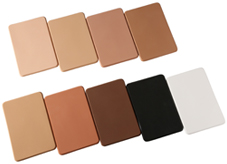
※It may differ from the actual color by the screen setting of the personal computer.
#BSC is a color based on the Japanese standard skin color (bare skin color).
#10, #20, #30, #40, and #50 are colors created based on foundation colors that are widely used in Japan.
In addition to the above, there are #BK (Black), #W (White), and #ZAJ-865 (Brown).
Urethane gel (11X gel) #BIO
| # | Target item: | Example of measurement | |||
|---|---|---|---|---|---|
| L* | a* | b* | △E | ||
| #BIO(BSC) | P.001-001 | 69.36 | 10.98 | 19.31 | within 1.5 |
| #10 | 69.31 | 10.31 | 20.35 | within 1.5 | |
| #20 | 64.11 | 13.58 | 17.02 | within 1.5 | |
| #30 | 61.73 | 12.15 | 20.27 | within 1.5 | |
| #40 | 60.73 | 10.79 | 22.68 | within 1.5 | |
| #50 | 54.55 | 17.85 | 21.89 | within 1.5 | |
| #W | 96.39 | -0.85 | 3.63 | within 1.5 | |
| #BK | 25.70 | -0.03 | -0.64 | within 1.5 | |
| #J865 | 41.36 | 9.12 | 12.78 | within 1.5 | |
Spectrophotometer:Konica Minolta CM-2500 d
Colorimetric value: Lab(SCI)
Light source:D65
View: 10 degrees(changed since June 20,2013)
As for the basic data above, there is a possibility that some fluctuation may occur due to change in pigment specifications.
For colors other than above, please contact our sales representative.
Urethane gel (11X gel) #BIO
| # | Target item: | Example of measurement | |||
|---|---|---|---|---|---|
| L* | a* | b* | △E | ||
| #BIO(BSC) | P.001-001 | 71.47 | 10.61 | 18.62 | within 1.5 |
| #10 | 73.80 | 8.66 | 18.66 | within 1.5 | |
| #20 | 69.04 | 12.10 | 15.49 | within 1.5 | |
| #30 | 66.37 | 11.07 | 19.20 | within 1.5 | |
| #40 | 65.26 | 9.85 | 21.90 | within 1.5 | |
| #50 | 59.46 | 16.70 | 21.43 | within 1.5 | |
| #W | 96.78 | -1.36 | 9.01 | within 1.5 | |
| #BK | 24.00 | -0.01 | -0.65 | within 1.5 | |
| #J865 | 45.46 | 9.41 | 14.28 | within 1.5 | |
Spectrophotometer:Konica Minolta CM-2500 d
Colorimetric value: Lab(SCI)
Light source:D65
View: 10 degrees(changed since June 20,2013)
As for the basic data above, there is a possibility that some fluctuation may occur due to change in pigment specifications.
For colors other than above, please contact our sales representative.
②-2 Color selection (New colors:Skin shade)
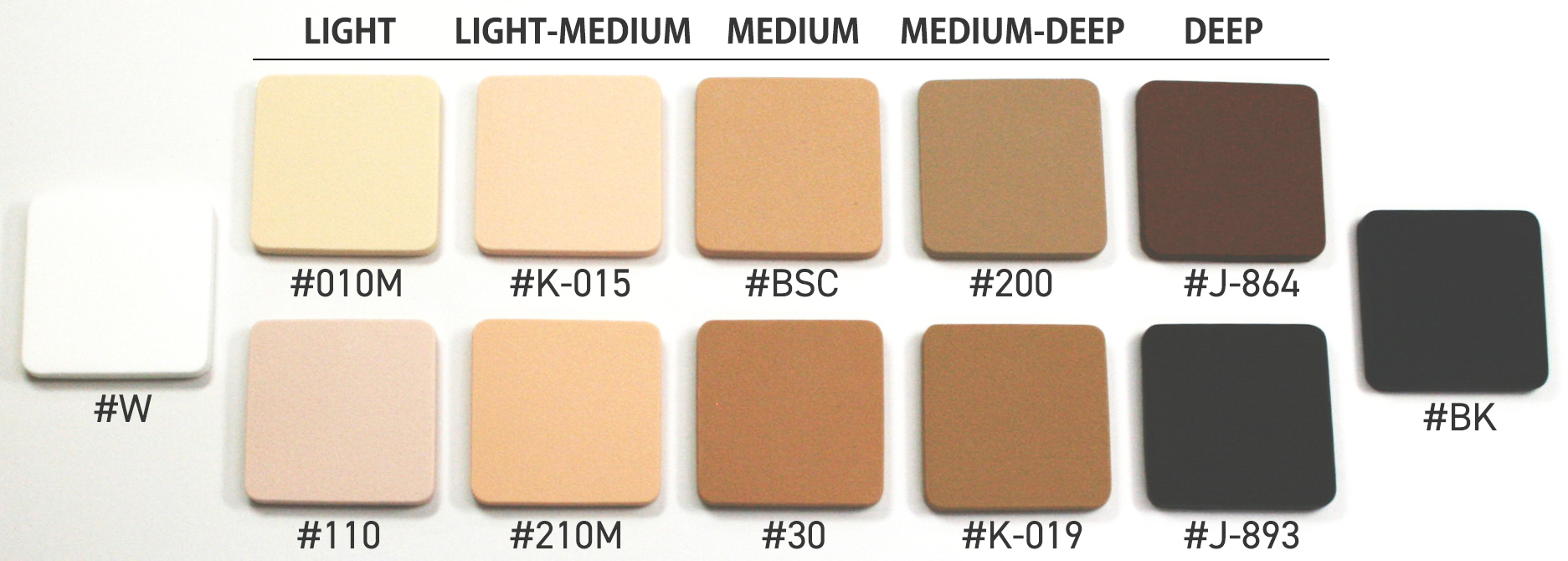
| # | Target item: |
Example of measurement | |||
|---|---|---|---|---|---|
| L* | a* | b* | △E | ||
| #W(Basic 9colors) | No.64 | 96.39 | -0.85 | 3.63 | within 1.5 |
| #010M(New colors) | 85.42 | 5.91 | 17.06 | within 1.5 | |
| #110(New colors) | 81.75 | 7.44 | 9.42 | within 1.5 | |
| #K-015(New colors) | 81.84 | 10.55 | 16.48 | within 1.5 | |
| #210(New colors) | 77.99 | 12.26 | 19.19 | within 1.5 | |
| #BSC(Basic 9colors) | 69.36 | 10.98 | 19.31 | within 1.5 | |
| #30(Basic 9colors) | 61.73 | 12.15 | 20.27 | within 1.5 | |
| #200(New colors) | 59.89 | 7.82 | 15.43 | within 1.5 | |
| #K-019(New colors) | 55.86 | 10.35 | 19.53 | within 1.5 | |
| #J-864(New colors) | 40.27 | 11.05 | 16.18 | within 1.5 | |
| #J-893(New colors) | 24.73 | 2.23 | 1.78 | within 1.5 | |
| #BK(Basic 9colors) | 25.70 | -0.03 | -0.64 | within 1.5 | |
Spectrophotometer:Konica Minolta CM-2500 d
Colorimetric value: Lab(SCI)
Light source:D65
View: 10 degrees(changed since June 20,2013)
As for the basic data above, there is a possibility that some fluctuation may occur due to change in pigment specifications.
For colors other than above, please contact our sales representative.
| # | Target item: |
Example of measurement | |||
|---|---|---|---|---|---|
| L* | a* | b* | △E | ||
| #W(Basic 9colors) | No.64 | 96.78 | -1.36 | 9.01 | within 1.5 |
| #010M(New colors) | 86.54 | 5.19 | 16.27 | within 1.5 | |
| #110(New colors) | 83.61 | 6.49 | 9.15 | within 1.5 | |
| #K-015(New colors) | 83.6 | 9.06 | 15.32 | within 1.5 | |
| #210(New colors) | 80.32 | 10.79 | 17.7 | within 1.5 | |
| #BSC(Basic 9colors) | 71.47 | 10.61 | 18.62 | within 1.5 | |
| #30(Basic 9colors) | 66.37 | 11.07 | 19.20 | within 1.5 | |
| #200(New colors) | 63.65 | 7.54 | 14.89 | within 1.5 | |
| #K-019(New colors) | 59.74 | 9.92 | 19.25 | within 1.5 | |
| #J-864(New colors) | 44.6 | 10.94 | 17.07 | within 1.5 | |
| #J-893(New colors) | 25.91 | 3.17 | 2.36 | within 1.5 | |
| #BK(Basic 9colors) | 24.00 | -0.01 | -0.65 | within 1.5 | |
Spectrophotometer:Konica Minolta CM-2500 d
Colorimetric value: Lab(SCI)
Light source:D65
View: 10 degrees(changed since June 20,2013)
As for the basic data above, there is a possibility that some fluctuation may occur due to change in pigment specifications.
For colors other than above, please contact our sales representative.
③Selection of surface modification
It is possible to give three kinds of feeling such as dry skin feeling, normal type or moisture skin feeling to the same model.
It can be used not only for sensory evaluation but also for friction measurement evaluation.
Kinds of surface modification
①Dry type(Dry skin feeling) ②Normal type ③Wet type(Moisture skin feeling)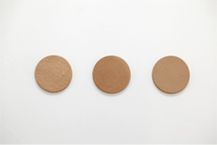
Mean dynamic friction
| Item | Type | N1 | N2 | N3 | Ave |
|---|---|---|---|---|---|
| NO10A | ①Dry | 0.872 | 0.866 | 0.859 | 0.866 |
| ②Normal | 0.952 | 1.17 | 0.948 | 1.023 | |
| ③Wet | 1.476 | 1.534 | 1.444 | 1.485 |
※It is a value measured with Cheek skin model No. 10A.
Other models also can be made with dry / wet type.
④Selection of UV responding chemical
UV responding chemical was mixed into BIODY model on which cosmetics is repeatedly applied.
This model makes it possible to examine UV shielding effect of UV care products such as foundation.
Selection of UV responding chemical
① with UV responding chemical
② without UV responding chemical
